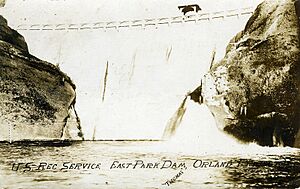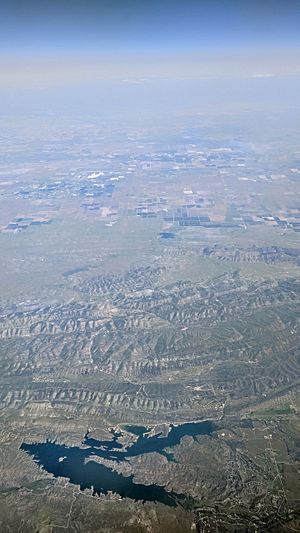East Park Dam facts for kids
The East Park Dam is a special dam in California. It was built by the United States Bureau of Reclamation to help farmers water their crops. This important dam is located on Little Stony Creek, about 30 miles southwest of Orland, California. It sits at the northern end of the California Central Valley.
The dam was finished in 1910. It is a strong, curved concrete dam, standing 92 feet tall. It has two special gates to control the water flow. The building that controls these gates looks like a unique pagoda. The spillway, which lets extra water out, is about 2,000 feet south of the dam. It has cool, curved fins. The lake behind the dam, called East Park Reservoir, can hold a lot of water. It has a storage capacity of 51,000 acre-feet. An acre-foot is enough water to cover one acre of land with one foot of water.
Sometimes, experts check fish in lakes for things that might not be good for you. The California Office of Environmental Health Hazard Assessment (OEHHA) has given advice for East Park Reservoir. This advice helps people know how much fish is safe to eat from the lake. This way, everyone can enjoy fishing safely.
The Orland Project: A Water Story
The East Park Dam and its reservoir were a key part of a bigger plan called the Orland Project. This project was one of the earliest and smallest ever started by the Bureau of Reclamation. It was designed to bring water to farms in the area.
Other important parts of the Orland Project include:
- The Stony Gorge Dam and Reservoir, built in 1928. This dam is about 18 miles downstream from East Park Dam. It's an early example of an Ambursen-style dam.
- The Rainbow Diversion Dam, completed in 1914.
- The Northside Diversion Dam, built in 1913 and later rebuilt in the 1950s.
- A large system of canals. This system includes 17 miles of main canals and 117 miles of smaller connections. These canals carry water to many farms.
The Orland Project is still working today! A local group called the Orland Unit Water Users' Association has been running the project since October 1, 1954. Because of its history and importance, the project was added to the National Register of Historic Places in the 1980s.



